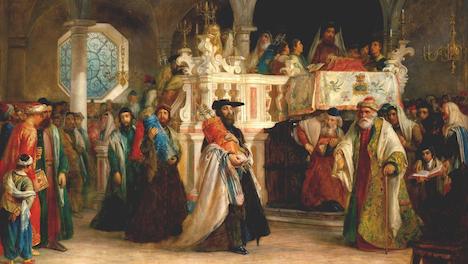1. Simchat Torah Comes After Sukkot
Shemini Atzeret (“The Eighth [Day] Gathering”) comes after 7 days of Sukkot. On it, we celebrate Simchat Torah (“The Joy of the Torah”), since it is the day when we finish the annual Torah-reading cycle and begin anew.
2. In the Diaspora It Is Two Days Long
The first day is simply called Shemini Atzeret (since, counting from day one of Sukkot, it’s the eighth day), and the second day, when the Torah is completed, is known as Simchat Torah.
3. We Sit In the Sukkah Without a Blessing
Read: A Deeper Look at Shemini Atzeret/Simchat Torah
4. It Is Its Own Holiday in Six Respects
- In Temple times, there would be a separate raffle to determine which priests would be honored with performing the various services of the day, unrelated to the raffle held for the Sukkot honors.
- We say the Shehecheyanu blessing (either when lighting candles or when saying Kiddush), thanking G?d for bringing us to the milestone of this new holiday.
- It is its own festival, as evidenced by the fact that we do not sit in the sukkah.
- The musaf (“additional”) offering brought in the Holy Temple was different from that which was brought on Sukkot.
- The Levites sang a different song in the Temple, Psalm 12, which begins, “For the choirmaster on the eighth.”
- The liturgy said at Kiddush is different, clearly describing it as a different holiday with a different name.
5. We Light Candles Each Night
Like on all holidays, we usher in the day with candle-lighting before the evening meal (when Shemini Atzeret coincides with Shabbat, be sure not to light the candles on Shabbat). On the second night, make sure to kindle your candles from a pre-existing flame, since striking a match or lighting a lighter is forbidden.
6. We Say Yizkor on the First Day
7. We Begin to Mention Rain
Interestingly, we do not begin to ask for rain until several weeks later (on the 7th of Cheshvan in Israel, or in early December in the diaspora). Read the reason for this disparity here.
8. We Circle the Synagogue at Night and By Day
On Simchat Torah evening and morning (as well as on Shemini Atzeret eve in some communities), there is a special ceremony called hakafot (“circling”). The Torah scrolls are removed from the ark and joyously paraded around the bimah, the reading platform in the center of the synagogue, seven times.
Read: Simchat Torah Hakafot Procedure
9. Everyone Dances
Read: A Brother’s Wedding
10. We Celebrate Finishing the Torah and Starting Anew
On Simchat Torah morning, we read from three Torah scrolls1 (if the synagogue has three scrolls). The first scroll is used to read the final portion of the Torah, Vezot Haberachah; the second is used for the first portion of Bereishit, Genesis; and the verses describing the sacrifices of the day are read from the final Torah. The person called up for the final aliyahof the Torah is known as the chattan Torah (“Torah groom”) and the person called for the opening verses of the Torah is called chattan Bereishit (“Genesis Groom”).
11. The Priestly Blessing Is Done Early
Learn more about the Priestly Blessings.
12. We Eat Stuffed Cabbage
Read more reasons for eating stuffed cabbage on Simchat Torah.
13. In Cairo, Everyone Would Join Together
14. It Is G?d’s Goodbye Party
This is our final party with G?d before we enter the year ahead, supercharge and inspired by the holiday.
Read: The Peasants and the Palace
15. Simchat Torah With the Rebbe Was an All-Night Affair
In Brooklyn, New York, the Rebbe’s Simchat Torah celebration would begin late at night and continue into the wee hours of the morning. The thousands of celebrants from all over the world were traditionally joined by Israeli diplomats who were granted the privilege of speaking with the Rebbe for a few moments during the proceedings. Between 1954 and 1963, the Rebbe would teach a new niggun (Chasidic melody) every year following the night’s dancing and singing.
Source: Chabad.org
